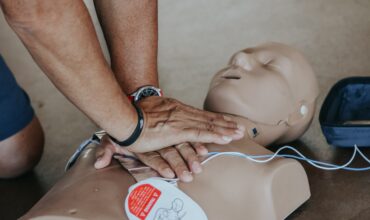- Your cart is empty
- Continue Shopping


Ventricular fibrillation (VF) is a type of abnormal heart rhythm that occurs when the electrical signals in the heart become disorganized and the heart’s lower chambers (ventricles) quiver instead of contracting in a coordinated way. This can prevent the heart from pumping blood effectively, which can lead to cardiac arrest and result in serious injury or death if not treated promptly.
Ventricular fibrillation is a medical emergency that requires immediate treatment, typically with a defibrillator. A defibrillator is a device that delivers an electrical shock to the heart in an effort to restore a normal heart rhythm. In many cases, this shock is successful in restoring normal heart function, but it is important to act quickly because the longer the heart is in VF, the more likely it is to suffer damage.
Other treatments for VF may include medications to try to restore a normal heart rhythm and CPR to help maintain blood flow to the body until the heart can be restored to a normal rhythm. In some cases, more advanced medical interventions, such as a pacemaker or an implantable cardioverter defibrillator (ICD), may be necessary to help prevent future episodes of VF.
Refractory ventricular fibrillation (RVF) is a type of ventricular fibrillation (VF) that is resistant to treatment with a defibrillator. VF is a type of abnormal heart rhythm that occurs when the electrical signals in the heart become disorganized and the heart’s lower chambers (ventricles) quiver instead of contracting in a coordinated way. This can prevent the heart from pumping blood effectively, which can lead to cardiac arrest and result in serious injury or death if not treated promptly.
Typically, VF is treated with a defibrillator, which is a device that delivers an electrical shock to the heart in an effort to restore a normal heart rhythm. In many cases, this shock is successful in restoring normal heart function. However, in some cases, the VF may persist even after the defibrillator shock, a condition known as RVF.
RVF is a medical emergency that requires additional treatment, such as medications to try to restore a normal heart rhythm or more advanced medical interventions, such as a pacemaker or an implantable cardioverter defibrillator (ICD). It is important to act quickly in cases of RVF because the longer the heart is in VF, the more likely it is to suffer damage.
Atrial fibrillation with rapid ventricular response, also known as uncontrolled atrial fibrillation, is a type of abnormal heart rhythm that occurs when the electrical signals in the heart become disorganized and the heart’s upper chambers (atria) quiver instead of contracting in a coordinated way. This can cause the heart to beat in an irregular and rapid way, which is called atrial fibrillation.
Atrial fibrillation can cause the heart to pump less effectively, which can lead to symptoms such as fatigue, shortness of breath, and palpitations. In some cases, atrial fibrillation can also cause the heart’s lower chambers (ventricles) to beat in an irregular and rapid way, which is known as a rapid ventricular response. This can be dangerous because it can put extra strain on the heart and increase the risk of serious complications, such as stroke or heart failure.
Treatment for atrial fibrillation with rapid ventricular response may include medications to try to restore a normal heart rhythm, procedures to try to prevent the heart from beating in an irregular way, or more advanced medical interventions, such as a pacemaker or an implantable cardioverter defibrillator (ICD). It is important to work with a healthcare provider to determine the best treatment plan for your individual needs.
| Condition | Description | Treatment |
|---|---|---|
| VF | Abnormal heart rhythm in which the heart's lower chambers (ventricles) quiver instead of contracting in a coordinated way. Can lead to cardiac arrest. | Defibrillator shock, medications to restore a normal heart rhythm, CPR, advanced medical interventions (e.g. pacemaker, ICD) |
| RVF | VF that is resistant to treatment with a defibrillator. | Additional medications to restore a normal heart rhythm, advanced medical interventions (e.g. pacemaker, ICD) |
| A-FIB | Abnormal heart rhythm in which the heart's upper chambers (atria) quiver instead of contracting in a coordinated way. Can cause the heart to beat in an irregular and rapid way. | Medications to restore a normal heart rhythm, procedures to try to prevent the heart from beating in an irregular way, advanced medical interventions (e.g. pacemaker, ICD) |
An Automated External Defibrillator (AED) is a device that can be used to help treat ventricular fibrillation (VF), a type of abnormal heart rhythm that occurs when the electrical signals in the heart become disorganized and the heart’s lower chambers (ventricles) quiver instead of contracting in a coordinated way.
This can prevent the heart from pumping blood effectively, which can lead to cardiac arrest and result in serious injury or death if not treated promptly.
An AED is designed to deliver an electrical shock to the heart in an effort to restore a normal heart rhythm. When a person is experiencing VF, their heart is in a state of abnormal electrical activity, and the shock from an AED can help correct this abnormal activity and restore a normal rhythm.
There has been a significant amount of research conducted in an effort to better understand ventricular fibrillation (VF) and improve treatment for this condition. Some of the areas that have been studied include the causes of VF, the risk factors associated with the development of VF, and the most effective treatment options.
One of the key areas of research in VF has focused on understanding the underlying mechanisms of the condition. Researchers have studied the electrical activity of the heart during VF and have developed models to better understand how VF develops and how it can be treated.
Other research has focused on identifying risk factors for VF, such as certain medical conditions, lifestyle factors, and genetic predispositions. This research has helped to identify populations that may be at higher risk for VF and has led to the development of strategies to prevent the development of VF in these individuals.
There has also been significant research on the most effective treatment options for VF. This includes research on the use of defibrillators, medications, and other medical interventions to restore a normal heart rhythm and improve outcomes for people experiencing VF.
Overall, the research on VF has helped to improve our understanding of this condition and has led to the development of more effective treatment options. This research will continue to be an important area of focus as researchers work to improve outcomes for people with VF.
Implementation Guide